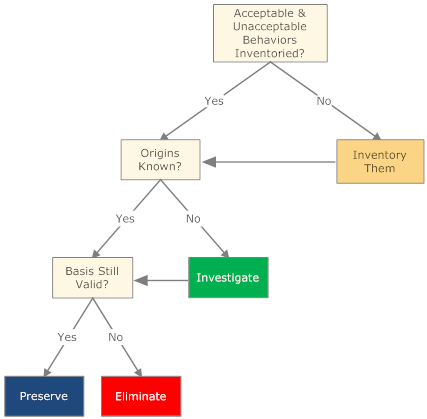Written by Fred Nickols
Did you ever wonder how your company's culture – that set of beliefs, traditions, and behavioral norms that determines "the way things work around here" – came to be? Or why, when you try to change it, it seems so resistant? Well, here's a little story about a scientific experiment that shows how culture comes into being and why it is so resistant.
The experimenters began with a cage, a set of externally enforced boundaries. Inside the cage, they hung a banana on a string and placed a set of stairs under it. They then introduced five monkeys into the cage. Before long, one of the monkeys started to climb the stairs toward the banana. As soon as it touched the stairs the experimenters sprayed all the other monkeys with really cold water. When another monkey made an attempt to get the banana they again sprayed the other monkeys with cold water. After a while the monkeys prevented any of their group from going after the banana.
After the cultural prohibition against "going for the banana" had been established the experimenters put away the cold water. They took one of the original monkeys out of the cage and introduced a new one. Upon spotting the banana the new monkey went after it. To its surprise and dismay all of the other monkeys attacked it. After another attempt and attack the new monkey learned that if it tried to climb the stairs and get the banana it would be assaulted and so it stopped going after the banana. It had been acculturated, assimilated into the cage's "don't go for the banana" culture.
Next the experimenters removed another of the original five monkeys and replaced it with another new one. The second new monkey went to the stairs and predictably it was attacked. The first new monkey took part in this punishment with enthusiasm! Similarly a third original monkey was replaced with a new one, then a fourth, then the fifth.
Every time the newest monkey took to the stairs it was attacked by the other monkeys. Most of the monkeys that were beating it had no idea why they were not permitted to climb the stairs or why they were participating in the beating of the newest monkey. After all the original monkeys were replaced none of the remaining monkeys had ever been sprayed with cold water. Nevertheless, no monkey ever approached the stairs to try for the banana. Why not? Because as far as they knew: "That's the way it's always been done around here."
And that is how a company's culture is formed: Acceptable and unacceptable behaviors are initially established in response to important external events but, over time, all that remains are strongly-held notions about what is and what isn't acceptable behavior. The origins of these beliefs vanish with the departure of the members of the group who were present when the patterns and standards were initially established. In a long-lived organization, there might be no members left who know why a given behavior is considered acceptable or unacceptable. Yet all members of the organization are quick to enforce whatever the cultural standards might be.
So how do you break out of this culture trap? Well, you start by trying to find out what's behind those cultural do's and don'ts. Why is this expected or required? Why is that prohibited? And don't accept "That's the way things are done around here" as an answer. In some cases, you might find there are very good reasons for this or that prohibition or requirement. In others you won't. In all cases, what you're out to accomplish is to eliminate blind adherence to behavioral norms.
If you want to prevent hardening of the cultural arteries, try this: Every two or three years, conduct a simple cultural audit (see the decision tree below). Identify whatever behavioral norms are at work and determine why they are in place. See if they are still valid. None of this means that all or even any cultural standards will be eliminated; what it does mean is that if they no longer make any sense you can probably do away with them and, if they are to stay in place, people will know why – and your company's culture will make sense instead of simply being a case of monkey see, monkey do.

About the Author: My name is Fred Nickols. I am a writer, an independent consultant and a former executive. Visual aids of one kind or another have played a central role in my work for many years. My goals in writing for SmartDraw's Working Smarter blog are to: (1) provide you with some first-rate content you can't get anywhere else, (2) illustrate how important good visuals can be in communicating such content and (3) illustrate also the critical role visuals can play in solving the kinds of problems we encounter in the workplace.